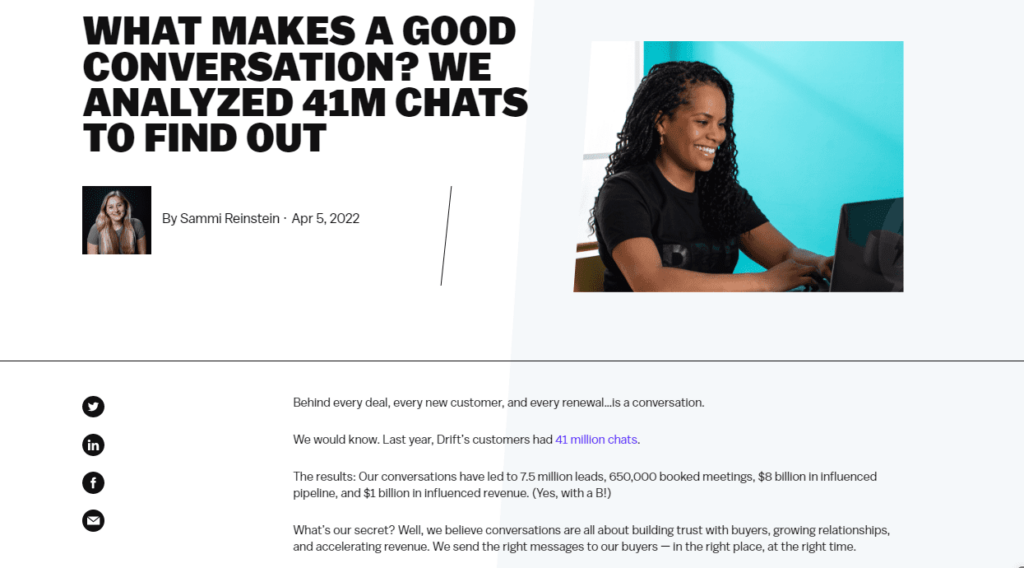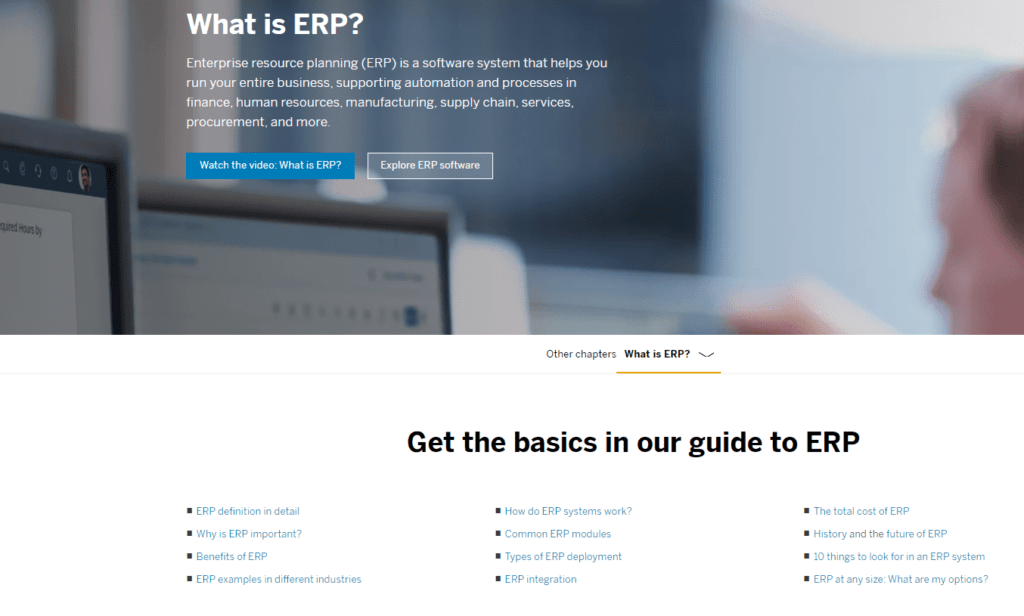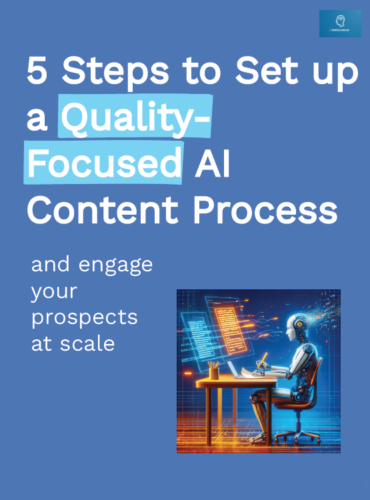It’s a fact: B2B prospects are increasingly looking for reliable and expert-level content.
This is especially the case if you’re selling a complex and technical product. B2B buyers know their business inside and out and expect to read a piece from a credible source.
But how to sound like an expert?
Here’s how to leverage expert resources or talents to create rock-solid content.
What makes expert content different from other content?
Compared to average content, expert content is all about leaving readers with a sense of authority and trust. While that might seem subjective, it can definitely rely on objective factors.
That’s what Google has enforced with its “E-A-T” –and now renamed “E-E-A-T”- rules. In 2014, Google announced that its algorithm was favoring content that demonstrates both Expertise, Authoritativeness, and Trustworthiness. It could now assess whether a piece of content displays deep and credible knowledge of the field. Based on that assessment, it could tell whether it should feature it or not.
On top of that, in December 2022, Google added the “Experience” factor. This last rule promotes content that are showing personal experience in the subject.
The E-E-A-T standard is a good way to discriminate between random content and truly expert content. Concretely, you can tell E-E-A-T content apart because it includes :
- Accurate knowledge of the industry (sound definitions and references).
- Relevant and value-adding advice and recommendations.
- Hands-on case studies, stories, or experiments that prove genuine professional experience.
- Solid research and/or data.
- Subject-matter expert quotes, references, or insights.
- Trustworthy author and company description.
The Benefits of Expert-level Content
What can you expect from adding an expert touch to your content? Actually, a lot of things.
From a marketing standpoint, you can benefit from:
- Better SEO ranking.
- More qualified and valuable leads.
- Higher lead conversion rate.
- More trust and more credibility and thus more buyers.
Ready to take the plunge?
How to turn your average content into expert content: a step-by-step approach
Creating expert-level content requires a well-thought-out creation process.
Here’s a step-by-step method you can apply to make sure your content feels like an expert-level resource:
#1 Find the common pain points of your customers
Many content start by giving their expertise straight away, without much consideration for the needs of their audience. The way to expert content is first to understand what your customer’s needs and pains are. The better you can pinpoint the subjects and worries of your prospects, the more you can provide them with content they can trust.
To do that, you can for example listen to your sales reps’ calls or call recordings. This will help you get a glimpse of key data:
- What are your prospect’s main concerns?
- Which features of your product or service are they the most interested in?
- Which content subjects will they find the most useful?
- What problem would they need help with from you?
With the answers to these questions, you’ll be able to choose the best subjects and problems for your expert content.
#2 Take information from subject-matter experts
Having many content ideas in mind, you can now ask the opinions of experts on the subject. You can interview internal or external subject-matter experts. Or, as a substitute, you can leverage the expert resources from your company (technical documentation, internal processes, and research…).
Subject-matter experts might be unavailable or hard to convince. There’s nothing wrong with that. Delivering content for marketing is not their primary job. Yet, you can highlight to them the tangible benefits of helping you out. You can win them over via the following approach:
- Reach out to them, explain the purpose of your content (educating prospects and generating more revenue), and tell them how much their contribution will be appreciated.
- Find a convenient date and book a 45-min meeting with them.
- Get their input on the topic and record their answer. Give them a chance to express all their thoughts by favoring open-ended questions.
- Inquire critically about their response and encourage them to elaborate on key points. Experts often assume we know what they’re talking about. It’s your job to make sure that every new concept and idea they introduce is easy to understand.
- Thank them for their input, and promise to keep them informed of the results and to credit them on the final work.
#3 Find a compelling and value-adding angle
You might not only gather interesting materials and inputs. With your subject-matter expert, you might also agree on a compelling angle to address the subject.
True expert content introduces a new way of thinking about old-recurring problems, and that’s your job to figure it out.
To find out your NPOV (new point of view), you can challenge your existing ideas via the Thesis-Antithesis-Synthesis framework:
- Describe and explain the opposing ideas and views that already exist on the subject. Demonstrate how each of them is providing valuable and relevant inputs to the topics. (Thesis)
- Examine these views against each other, point out their weaknesses, and show their limitations in dealing with the current state of the industry. (Antithesis)
- Incorporate these contradictory viewpoints from a new all-encompassing perspective. Show how this new synthetic perspective will help your readers better resolve the issue at hand. (Synthesis)
This NPOV will help you build your key argument and establish the heart of your content outline.
#4 Outline the Content Structure
Now is the time to get to actually writing your expert content. You can follow this step-by-step structure to ensure that your content is organized and logical:
1. A strong introduction
Your introduction needs to bring all the necessary elements to make your audience eager to read. You want to stress the importance of the issue or problem you are dealing with, and why readers should check out the solution you’re bringing to them. You can for example mention surprising stats, noteworthy news of the industry, or a personal observation on the field. You can add context about the subject, or challenge your readers’ false assumptions.
These will then help you introduce your general problem and your NPOV. You can state them at the end of your introduction.
2. Key expert points that answer the general question
You’ve got your general question, now is the time to bring your expert point of view. You might approach your main argument from different angles and thus divide it into several sections. The important point here is to answer every question your audience has in mind when dealing with the subject. That means writing the following sections:
- What: in some cases, you need to present a clear and simple definition of the notions at hand.
- Why: why does this subject matter, and what are the benefits of considering it?
- How: the most important part. You can answer the “how” by providing detailed instructions or bullet points to guide the reader.
- Who: who does this subject matter the most, and who should be involved to talk about it?
- Where and when: Which kind of companies should give serious consideration to this subject? When should this topic be brought to the table?
- How much: what are the financial calculations at stake? Price of the products? Exact cost-analysis? Return on investment?
3. Research, case studies, or personal experiments that defend the claim
Within each section of the body, you can defend your claims and explanation with solid evidence. You can mention :
- Inputs from quantitative research or qualitative survey.
- Description of case studies of related companies or professionals.
- Personal stories or observations to support your argument.
Remember: the mark of an expert is to always bring additional details and references to support his/her claims.
4. Actionable recommendations
Apart from demonstrative and educative references, you also want to bring recommendations that are applicable. Readers are looking for an expert who can help them advance their business and practice. And they want to be sure that this advice and tips drive concrete results.
This means giving them engaging and authentic recommendations like :
- A visual framework that compiles key data in one engaging graphic.
- A detailed step-by-step method.
- Real business cases to draw lessons from.
- Properly explained success stories.
5. External details about the content
As well as Google, most people are used to looking for external signs of authority in a text. These indicators give them more information about where this content came from. You might make the following details more evident on your content page to build trust with your readers:
- The name and bio of the authors, and whether they are affiliated or not to the company.
- A link to the company’s about section.
- Bibliography or a list of source references.
Which format for your expert content?
Writing is not the only way to convey your expertise in a specific field. Actually, expert content can come in many formats :
- 2000-word blog article.
- 6000-word white paper.
- 30-min videos: expert interview, Q&A, conferences, explainer, animation, storytelling…
The only restriction to qualify as expert content is that it delivers accurate and relevant insights as described above.
5 Examples of Great Expert-level content
These blog posts are great examples of expert-level content due to their in-depth information, detailed analysis, and semantic richness. Let’s see how each of them is connecting with their target audience.
1. Universal Robot: “Manufacturing Labor – The Crisis Continues”

This blog post is a thorough examination of the ongoing labor crisis in the manufacturing industry. It presents relevant data, statistics, and surveys to support a central argument: using cobots to fill the labor gap. Additionally, the post is structured logically, addressing the subject from multiple angles (What is the situation, why it is important, and what to do). The use of rich visuals and infographics adds to the clarity, providing readers with a visual representation of key facts and trends. The author’s as an expert-level source of information also solidifies the blog’s credibility.
2. Drift: “What Makes a Good Conversation?”

Drift’s article draws on the professional insights of two in-house subject-matter experts, as well as substantial data gathered from 41 million chats processed by Drift. It provides a visual framework that demonstrates how to establish effective communication between brands and customers in today’s digital landscape. It also offers concrete examples of successful conversation systems, that make it easily digestible. Furthermore, the article offers a 4-step method for brands to apply immediately to create engaging conversation systems.
3. Premium Beat “Build a Foolproof Budget for Your Short Film or Video”

The Premium Beat article brings a very comprehensive and detailed approach to film budgeting. The author showcases their expertise by addressing various angles of film budgeting, such as breaking down the costs into different categories, providing practical tips and calculations, and advising readers on potential pitfalls to avoid. The inclusion of precise examples of budget templates and software further enhances the credibility of the article, illustrating the writer’s in-depth knowledge and understanding of the film industry. By emphasizing the importance of efficient budget management and offering valuable insights, this article serves as an invaluable resource for anyone looking to produce a short film or video.
4. SAP “What is ERP”

Although it’s a basic SEO-optimized article, SAP’s piece of content is a very in-depth exploration of ERP systems, making it a perfect introduction for novice readers. It examines every aspect of the subject, such as the rationale behind implementing an ERP, its different types, and the benefits it can offer businesses. It includes engaging infographics and an animated video that makes the content more accessible. Furthermore, it concludes with a compelling use case that showcases the practical implementation of ERP, further solidifying the article’s expertise on the subject.
5. First Round “What I learned scaling engineering teams”

The First Round article features a first-person account from a renowned CTO in the startup world. This knowledgeable expert shares personal experience and insights on the challenges and successes of scaling engineering teams. He delivers a unique perspective on the topic by describing the intricacies involved in hiring, managing, and promoting technical teams. The author’s candid recount of their experiences, both positive and negative, but also provides well-presented advice derived from real-world scenarios.
Now you know what expert-level content looks like. Your turn to express your deep knowledge of your industry!





